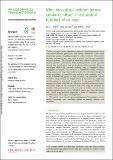Files in this item
When does cultural evolution become cumulative culture? : a case study of humpback whale song
Item metadata
| dc.contributor.author | Garland, Ellen Clare | |
| dc.contributor.author | Garrigue, Claire | |
| dc.contributor.author | Noad, Michael | |
| dc.date.accessioned | 2021-12-16T10:30:13Z | |
| dc.date.available | 2021-12-16T10:30:13Z | |
| dc.date.issued | 2022-01-31 | |
| dc.identifier | 276193713 | |
| dc.identifier | 0805e770-0f13-4edd-9427-b4af94b3988d | |
| dc.identifier | 85122391474 | |
| dc.identifier | 000729479600016 | |
| dc.identifier.citation | Garland , E C , Garrigue , C & Noad , M 2022 , ' When does cultural evolution become cumulative culture? a case study of humpback whale song ' , Philosophical Transactions of the Royal Society B: Biological Sciences , vol. 377 , no. 1843 , 20200313 . https://doi.org/10.1098/rstb.2020.0313 | en |
| dc.identifier.issn | 0962-8436 | |
| dc.identifier.other | ORCID: /0000-0002-8240-1267/work/105007149 | |
| dc.identifier.uri | https://hdl.handle.net/10023/24522 | |
| dc.description | Funding: ECG is currently funded by a Royal Society University Research Fellowship (UF160081). Previous song analysis contributing to this manuscript was supported by grants from the Sea World Research and Rescue Foundation Inc., the Australian Department of the Environment, Water, Heritage and the Arts, the Winifred Violet Scott Estate, and Tangalooma Marine Education and Research Foundation to MJN and ECG, an Australian Postgraduate award to ECG and from the International Fund for Animal Welfare (IFAW) to the South Pacific Whale Research Consortium (SPWRC). Surveys of humpback whales in New Caledonia were made possible by contributions from Fondation d’Entreprise Total and Total Pacifique, the Provinces Sud, North and Isles, and Inco S.A. | en |
| dc.description.abstract | Culture presents a second inheritance system by which innovations can be transmitted between generations and among individuals. Some vocal behaviours present compelling examples of cultural evolution. Where modifications accumulate over time, such a process can become cumulative cultural evolution. The existence of cumulative cultural evolution in non-human animals is controversial. When physical products of such a process do not exist, modifications may not be clearly visible over time. Here, we investigate whether the constantly evolving songs of humpback whales (Megaptera novaeangliae) are indicative of cumulative cultural evolution. Using nine years of song data recorded from the New Caledonian humpback whale population, we quantified song evolution and complexity, and formally evaluated this process in light of criteria for cumulative cultural evolution. Song accumulates changes shown by an increase in complexity, but this process is punctuated by rapid loss of song material. While such changes tentatively satisfy the core criteria for cumulative cultural evolution, this claim hinges on the assumption that novel songs are preferred by females. While parsimonious, until such time as studies can link fitness benefits (reproductive success) to individual singers, any claims that humpback whale song evolution represents a form of cumulative cultural evolution may remain open to interpretation. | |
| dc.format.extent | 11 | |
| dc.format.extent | 1102047 | |
| dc.language.iso | eng | |
| dc.relation.ispartof | Philosophical Transactions of the Royal Society B: Biological Sciences | en |
| dc.subject | Song | en |
| dc.subject | Cultural evolution | en |
| dc.subject | Cultural revolution | en |
| dc.subject | Complexity | en |
| dc.subject | Cetaceans | en |
| dc.subject | Social learning | en |
| dc.subject | GC Oceanography | en |
| dc.subject | QH301 Biology | en |
| dc.subject | QL Zoology | en |
| dc.subject | DAS | en |
| dc.subject | MCC | en |
| dc.subject.lcc | GC | en |
| dc.subject.lcc | QH301 | en |
| dc.subject.lcc | QL | en |
| dc.title | When does cultural evolution become cumulative culture? : a case study of humpback whale song | en |
| dc.type | Journal article | en |
| dc.contributor.sponsor | The Royal Society | en |
| dc.contributor.institution | University of St Andrews. Centre for Social Learning & Cognitive Evolution | en |
| dc.contributor.institution | University of St Andrews. Sea Mammal Research Unit | en |
| dc.contributor.institution | University of St Andrews. School of Biology | en |
| dc.identifier.doi | 10.1098/rstb.2020.0313 | |
| dc.description.status | Peer reviewed | en |
| dc.identifier.grantnumber | UF160081 | en |
This item appears in the following Collection(s)
Items in the St Andrews Research Repository are protected by copyright, with all rights reserved, unless otherwise indicated.

